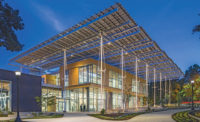U.Life. It sounds like a New Age movement. For developer Stanley C. Gale, the driving force behind the $35-billion Songdo International Business District, U.Life actually is a "new age movement" of sorts, except the "new age" is the digital age and the "movement" is variously called smart cities, intelligent urbanization or, in Gale's lexicon, ubiquitous life, or U.Life. If Gale has his way, everyone living and working in the 1,500-acre Songdo IBD will be linked through a common backbone of information and communications technology.
The master-planned new town in Incheon, Republic of Korea, is Gale's U.Life pilot project. He has taken steps to make the city the closest thing to the world's first managed "technopolis," at least on the buildings side. The approach is more than wiring individual buildings for high-speed internet. All the technology in the homes and businesses will be infused with artificial intelligence and next-generation networks that are managed by a master grid, for a truly smart city.
"We believe many of the technologies innovated, integrated and implemented in Songdo IBD will be exported to be deployed in future developments around the globe," says Tom Murcott, executive vice president of Gale International, New York City. "We have hosted numerous delegations intending to undertake [similarly scaled] development in other countries."
Since construction began in 2005, Songdo IBD has completed 100 buildings, containing 25 million sq ft. More than 25,000 crews are at work on 229 buildings that will contain 15 million sq ft.
A 390,812-sq-meter retail mall, an art museum and a hospital are under way. The 308-m-tall North East Asia Trade Tower has been delayed three years, mostly because of financing issues. NEATT, set to open in late 2013, is Korea's tallest high-rise. It will likely retain that distinction until the 555-m Lotte World Tower, coming out of the ground in Seoul, is done (see p. 38).
Songdo IBD ranks as the largest-ever private real estate undertaking. It is being developed by Gale International and Songdo-based POSCO E&C (Engineering & Construction) in a joint venture named the New Songdo International City Development LLC (NSIC). Gale is the lead developer and POSCO is doing the lion's share of construction. The master plan was developed by a team led by architect-planner Kohn Pedersen Fox Associates PC, New York City. There are several architects for individual buildings, including KPF.
NSIC won the competition to develop the Songdo IBD from the Incheon Free Economic Zone Authority. IFEZA remains the district's governing body.
The Songdo IBD is the heart of a 53.3-sq-kilometer Songdo free-trade zone for international businesses, which is one of three free-trade zones designated by IFEZA. The 169.5-sq-km free trade zone also includes the 98.4-sq-km Yeongjong zone for freight- and tourism-related businesses that surrounds the 10-year-old Incheon International Airport; and the 17.8-sq-km Cheongna zone, mostly for financial firms. IFEZA is trying to attract global firms to Incheon, billing it as a jetway to other Asian markets.
Eco-City
Even without the ubiquitous technology, the district—built on reclaimed land from the Yellow Sea on Incheon's west coast, 65 km from Seoul—is one of the world's most ambitious new-town projects. It is viewed as a model for livable cities. It is called an "eco-city" for its sustainable features and an "aerotropolis" for its proximity to Incheon International Airport—about 12.3 km to the west across the Incheon Bridge.
The city is also a pilot project of the U.S. Green Building Council's Leadership in Energy and Environmental Design neighborhood development program. Gale says Songdo IBD is the first to aspire to LEED certification for an entire city.









Post a comment to this article
Report Abusive Comment